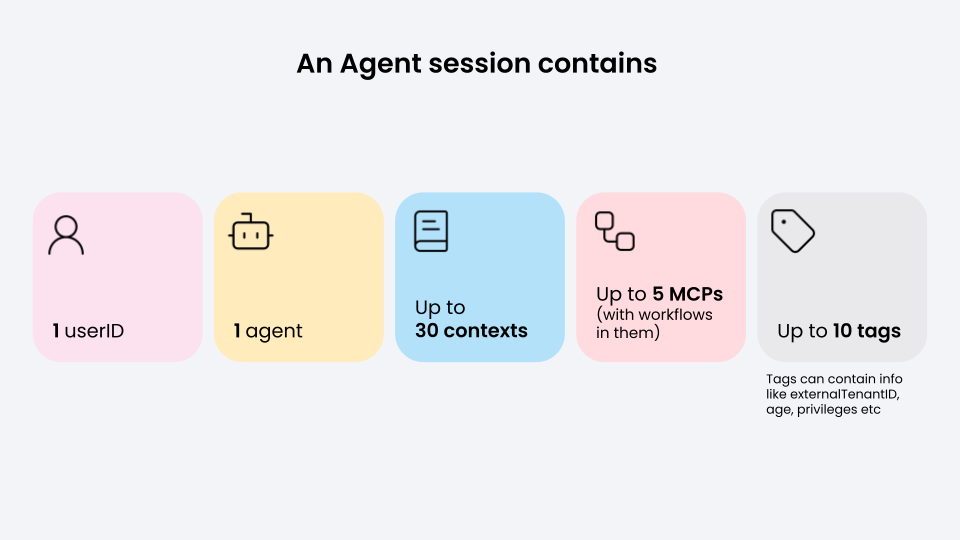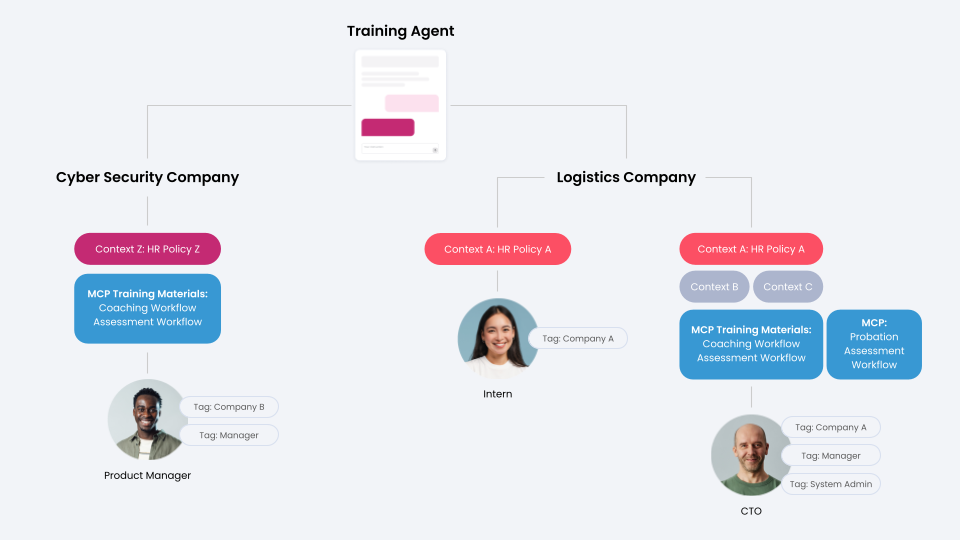Skip to main contentAt Mindset AI, we support multi-tenant systems and enable you to create personalized agent experiences using our Agent Sessions API.
Our Agent Sessions API makes it possible for one AI agent to serve many organizations while ensuring each one gets a fully customized and secure experience.
What is an Agent Session?
Each session is created with one user ID and one agent, but it can include:
- Up to 30 knowledge contexts
- Up to 5 MCP servers with workflows inside them
- Up to 10 tags with metadata (such as tenant IDs or user privileges)
You can think of an agent session as a secure container that ties everything together for a single user while they interact with an agent.
Mindset AI provides the flexibility, and you decide how these elements come together in your infrastructure.

Key Features
Programmatic Agent Assignment
- Assign the same AI agent or different AI agents that your teams have built to different users (e.g., HR Agent, Leadership Agent, Technical Agent)
- Users only see agents relevant to their role and permissions
- Pre-configure agent behavior, tone, and capabilities
- Mix and match any agent with any knowledge base programmatically
Private Knowledge Contexts
- Each tenant gets their own private knowledge context
- Granular control – users only see knowledge relevant to their role
- Tenants can upload documents, PDFs, and content into your platform
- Your team creates knowledge contexts based on tenant uploads
- Real-time content processing and indexing for users
- Different users get access to different workflows based on their role
- Seamless integration with CRM, HR systems, and monitoring tools
- Custom workflows built for specific tenant needs
Session-Based Security
- Every user interaction creates a secure, temporary agent session
- Sessions bind together the right agent, knowledge, and MCP server, which contains workflows for that specific user
The Power of Flexibility and Security
Using the Agent Sessions API, you can:
- Package different workflows inside your MCP server and assign them to an agent
- Assign different private knowledge contexts to the same agent so its answers are scoped only to that tenant’s material
This gives you complete flexibility and security. A single agent can look and feel the same across tenants, but pull from different knowledge and workflows.
Imagine running a corporate training platform where different companies use the same AI agent but need access to their own policies and workflows.
You configure a single Training Agent. The tenant-specific experience comes from how you create agentSessions in your own code.

Company 1: Cyber Security Company Setup
Product Manager gets an agentSessionUid that binds:
- Training Agent’s
agentUid
- Context Z (contains HR Policy Z)
- MCP server with coaching + assessment workflows
- Tags:
Company B, Manager
This Product Manager can only access Company B’s HR policies and has management-level privileges.
Company 2: Logistics Company Setup
Employee 1: Intern
agentSessionUid binds Training Agent to Context A (HR Policy A)- Tags:
Company A
The intern only accesses Company A’s HR policies through Context A. No workflows or tools are available.
Employee 2: CTO (Premium Package)
agentSessionUid binds Training Agent to multiple contexts: A, B, C, D- Two MCP servers:
- Coaching + assessment workflows
- Probation assessment workflow (premium feature)
- Tags:
Company A, Manager, System Admin
The CTO has the richest experience, with access to HR, technical docs, financial reports, and all premium workflows.
Key Benefits
In every case, it’s the same Training Agent, but because you choose which contextUids, workflows, and tags to attach when creating each agentSessionUid, every user gets a tailored experience.
Each tenant gets:
- Private knowledge contexts
- Custom workflows
- Secure multi-tenant separation
Use Cases for Your End Users
- Role-Based AI Access: Sales team gets CRM-connected agents, HR gets policy-focused agents
- Department-Specific Knowledge: Engineers see technical docs, executives see financial reports
- Secure Multi-Team Deployment: One AI platform serves many tenants with complete data separation
Conclusion
Mindset AI empowers you to turn traditional AI into flexible, role-aware agents that deliver real value in contexts like education, HR, or any industry where personalization and data security are critical.
Multi-tenancy transforms generic AI into personalized assistants that:
- Understand context
- Remember preferences
- Adapt to each user’s workflow
All while maintaining enterprise security and easy management. 
